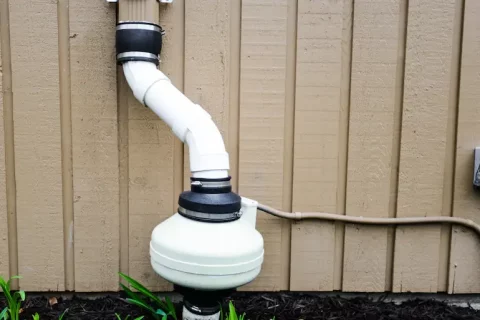Is Your Sump Pump Working Or ot? That’s Hard To Tell.
One of the most common questions we are asked is how to tell if a sump pump is working properly and what maintenance needs to be done on these components.
The truth is, most sump pumps do work properly as long as they have water in them. Some factors can affect their efficiency when the pump is running, but there’s no good way for you to know whether it is working or not without having access to the pump itself.
This short article will detail why this happens, how to check if it’s working properly, and what could lead to failure in those cases. We will also cover some things; you can look at the outside of the actual pump to see if anything is wrong with it and give you tips for prevention when possible!
Sump Pump Test: How to Determine Whether or Not a Sump Pump is Working
You can perform two simple tests to see if your sump pump is working or not. Detailed instructions are provided below for both tests.
1. Lift the Float
This is the easiest method, but it can be a little intimidating if you don’t know anything about plumbing. Before we begin, let’s understand what a float is.
What exactly are sump pumps float?
A float is a small weight that sits on top of the water. When it reaches certain depths, it drops off the side of the container holding the water and sinks. The water level then rises until all the weight is back on the top. This means that as the weight moves from one end of the tank to another, we can measure where the water stands by measuring any changes in height using a tape measure.
Steps to Follow:
- To turn the unit on, push the float as high up as possible.
- You will know the team is working when you see it kick on.
- You may skip ahead to the troubleshooting section if the device does not turn on.
- The more time you waste trying to find your float, the greater the chance of losing it. Use the second method below to dump water into the pit.
2. Dump Water into the Sump Pit
It’s foolproof to make sure your sump pump works by dunking water into its pit. Identifying its float can be difficult if you don’t know much about plumbing.
Steps to Follow:
- You can also use a 5-gallon bucket, trash can, cooler, or even 5-gallon jugs.
- Dump the water directly into the pit. It will work if the pump turns on.
- You will need to perform some troubleshooting if the pump does not start. Follow the steps in the next section to troubleshoot your sump pump.

How to Troubleshoot a Sump Pump
There is not much to them as far as sump pumps are concerned. Therefore, they are easy to troubleshoot. As a general rule, if the device is powered but not functioning, it must be replaced.
Unplug and Replug It
This is the gold standard to make sure any electronic device is functioning. Just like with a computer, it is a classic reboot. It’s funny how frequently this happens. In any case, this step is self-explanatory. Unplug and reconnect the cable. To test whether it worked, conduct one of the two tests above.
Ensure that the Outlet has Power
According to the code, sump pumps must be connected to a GFCI outlet. GFCI outlets have their switch, and should there be a problem, the outlet will turn off. They usually have a green light on them. A green light indicates an active outlet. When you plug something else into your unit’s outlet, if there is no green light, you may need to make sure it has power. Ensure that the outlet has power by pressing the rest switch and resetting the breaker.
Install a New Sump Pump
Power can be found at your outlet, but it probably needs to be replaced if your unit does not work. In most cases, sump pumps can be repaired, but replacing them is usually more efficient.
Here Are Some Common Reasons Why Sump Pumps Fail
A sump pump may fail for a variety of reasons. Some of them include:
- Having clogged sump pump pits, mechanical parts, float switches, or discharge lines will result in water backing up your basement. Regularly inspect your sump pump for damage and collected debris to help prevent it from clogging.
- If your sump pump freezes during a cold snap, it may malfunction. You will not be able to remove water from your basement if your sump pump freezes – or if even one of its parts, such as a drain line, freezes. Make sure the drain lines and sump pump are insulated to prevent freezing.
- Your sump pump will not work if it loses power. If your entire house loses power, such as during a storm, your sump pump will not be able to remove stormwater or any other rising water from your basement. Alternatively, the sump pump may have been unplugged and forgotten to be plugged in again.
- If your sump pump runs constantly, it will eventually burn out its motor due to overuse. In that case, you may want to upgrade your sump pump to a more powerful model that can handle large amounts of water more effectively.
Here Are Some Tips To Keep Your Sump Pump In Top Condition
To ensure that your sump pump works properly, you should follow the following steps:
Make Sure it Has a Lid
Keeping dirt and debris out of your sump pump will prevent it from becoming clogged. With a lid, the sump pump will run longer and more efficiently without being cleaned out or repaired.
Install the Right Size Sump Pump
The sump pump should be the right size. Sump pumps that are too small cannot handle large volumes of water. In the end, a sump pump that is too small may burn out. If it does not pump water correctly, it may fail. You will probably end up with a flooded basement either way. Consider upgrading to a larger model.
Provide Your Sump Pump with Constant Power
Even if your sump pump is in great condition to handle your water needs, it will do no good if it isn’t connected. To test your sump pump or free up outlet space in your basement, unplug it temporarily and plug it back in once you’re done.
In a power outage, a sump pump monitor can alert you to your home or business. Depending on the load sensor, you can also determine whether electricity is flowing to your sump pump or not.
Test the Float Switch
Make sure your sump pump is functioning properly by checking your float switches. Make sure your float switches are free of tangles and clog once in a while.
Pump Basins Should be Cleaned Annually
Keeping your sump pump in good working order also requires you to clean the pump basin yearly. When you thoroughly clean your pump, you remove dirt and debris that could impair its performance and compromise the safety of your business or home. You should pull the pump out of the basin, clean the pump inlet screen so water can enter the chamber freely, and then put it back in the bay.
When the Weather is Dry, Test the Sump Pump
It’s good to evaluate your sump pump’s reliability during extended dry periods like the summer months. Please verify that the outlet is supplying power, and make sure your sump pump is working properly by dumping water into it. Additionally, make sure the water flows freely out of the discharge pipe outside – if it doesn’t, locate and remove any obstructions.
Conclusion
If these testing methods don’t work, it is time to have the sump pump serviced. Sump pumps should be checked two times a year, before spring and fall.




